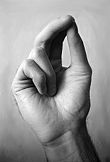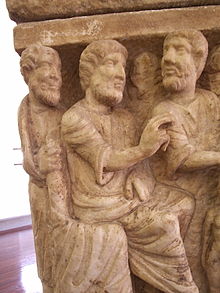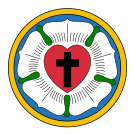- Sign of the Cross
-
For other uses, see Sign of the Cross (disambiguation).
The Sign of the Cross (Latin: Signum Crucis), or crossing oneself, is a ritual hand motion made by members of many branches of Christianity, often accompanied by spoken or mental recitation of a trinitarian formula.
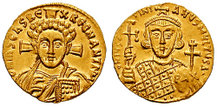 Gold coin made under the rule of Emperor Justinian II. (Byzantium. 7th century.)
Gold coin made under the rule of Emperor Justinian II. (Byzantium. 7th century.)
The motion is the tracing of the shape of a cross in the air or on one's own body, echoing the traditional shape of the cross of the Christian Crucifixion narrative. There are two principal forms: the older -- three fingers, right to left -- is exclusively used in the Eastern Orthodox churches and the Eastern Rites of the Catholic Church; the newer -- left to right, other than three fingers -- is the one used in the Latin-Rite Catholic Church, Anglicanism, Lutheranism and Oriental Orthodoxy (see below). The ritual is rare within other Christian traditions.
Contents
Gesture
- Hand
The open right hand is used in Western Christianity. The five open fingers are often said to represent the Five Wounds of Christ, although this symbolism was applied after the more ancient gesture of two or three fingers was simplified. Though this is the most common method of crossing by Western Christians, other forms are sometimes used. The West also employs the "Small Sign of the Cross" in which a small cross is traced with the thumb over the forehead, lips, and breast of the individual while whispering the words "May Christ's words be in my mind, on my lips, and in my heart". This is used at the Proclamation of the Gospel at Holy Mass and also is commonly used when blessing oneself with holy water when leaving or entering a church. In the Eastern Orthodox and Eastern Catholic Churches, the thumb, index, and middle finger are brought to a point, symbolizing the Trinity (the Father, Son and the Holy Spirit/Ghost, three persons sharing a single essence), the remaining two fingers (kept pressed together and touching the palm) representing the human and divine natures of Jesus Christ. However, the Russian Orthodox in the past used two fingers brought to a point with the three remaining fingers pressed down. Russian Old Believers still use this form. The Oriental Orthodox (Armenians, Copts, Ethiopians etc.) generally use the "Western" direction as well, though often with the Byzantine finger formation.
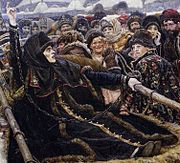 Detail of the painting Boyarynya Morozova by Vasily Surikov depicting a defiant Old Believer holding up two fingers (instead of three) during her arrest.
Detail of the painting Boyarynya Morozova by Vasily Surikov depicting a defiant Old Believer holding up two fingers (instead of three) during her arrest.
In Russia, until the reforms of Patriarch Nikon in the 17th century, it was customary to make the sign of the cross with two fingers (symbolising the dual nature of Christ). The enforcement of the three-finger sign was one of the reasons for the schism with the Old Believers whose congregations continue to use the two-finger sign of the cross.
- Motion
The sign of the Cross is made by touching the hand sequentially to the forehead, lower chest or navel area, and both shoulders, accompanied by the Trinitarian formula: at the forehead In the name of the Father (or In nomine Patris in Latin); at the stomach or heart and of the Son (et Filii); across the shoulders and of the Holy Spirit/Ghost (et Spiritus Sancti); and finally: Amen.
There are several interpretations, according to Church Fathers:[1] the forehead symbolizes Heaven; the stomach, the earth; the shoulders, the place and sign of power.
 Position of the fingers used by Old Believers while making the sign of the cross.
Position of the fingers used by Old Believers while making the sign of the cross.
There are some variations: for example a person may first place the right hand in holy water. After moving the hand from one shoulder to the other, it may be returned to the stomach. It may also be accompanied by the recitation of a prayer e.g. the Jesus Prayer, or simply "Lord have mercy". In some cultures it is customary to kiss one's hand or fingers at the conclusion of the gesture.
SequenceTheodoret (393–457) gave the following instruction:
This is how to bless someone with your hand and make the sign of the cross over them. Hold three fingers, as equals, together, to represent the Trinity: God the Father, God the Son, and God the Holy Ghost. These are not three gods, but one God in Trinity. The names are separate, but the divinity one. The Father was never incarnate; the Son incarnate, but not created; the Holy Ghost neither incarnate nor created, but issued from the Godhead: three in a single divinity. Divinity is one force and has one honor. They receive on obeisance from all creation, both angels and people. Thus the decree for these three fingers.
"Dogmatic Sarcophagus", 350 A.D., Earliest known depiction of the Trinity[2] Vatican Museums, Rome, Italy.
You should hold the other two fingers slightly bent, not completely straight. This is because these represent the dual nature of Christ, divine and human. God in His divinity, and human in His incarnation, yet perfect in both. The upper finger represents divinity, and the lower humanity; this way salvation goes from the higher finger to the lower. So is the bending of the fingers interpreted, for the worship of Heaven comes down for our salvation. This is how you must cross yourselves and give a blessing, as the holy fathers have commanded.
Peter of Damascus (12th Century) gave the following instruction:
Then we should also marvel how demons and various diseases are dispelled by the sign of the precious and life-giving Cross, which all can make without cost or effort. Who can number the panegyrics composed in its honor? The holy fathers have handed down to us the inner significance of this sign, so that we can refute heretics and unbelievers. The two fingers and single hand with which it is made represent the Lord Jesus Christ crucified, and He is thereby acknowledged to exist in two natures and one hypostasis or person. The use of the right hand betokens His infinite power and the fact that He sits at the right hand of the Father. That the sign begins with a downward movement from above signifies His descent to us from heaven. Again, the movement of the hand from the right side to the left drives away our enemies and declares that by His invincible power the Lord overcame the devil, who is on the left side, dark and lacking strength.
Pope Innocent III (1198–1216) gave the following instruction:
The sign of the cross is made with three fingers, because the signing is done together with the invocation of the Trinity. ... This is how it is done: from above to below, and from the right to the left, because Christ descended from the heavens to the earth, and from the Jews (right) He passed to the Gentiles (left). Others, however, make the sign of the cross from the left to the right, because from misery (left) we must cross over to glory (right), just as Christ crossed over from death to life, and from Hades to Paradise. [Some priests] do it this way so that they and the people will be signing themselves in the same way. You can easily verify this — picture the priest facing the people for the blessing — when we make the sign of the cross over the people, it is from left to right...
Writers such as Herbert Thurston, author of the article "Sign of the Cross"[3] in the Catholic Encyclopedia interpret this as indicating that at that time both Eastern and Western Christians moved the hand from the right shoulder to the left. However, Thurston confesses that the point is not entirely clear. He quotes another liturgist who inclined to the opinion that in this passage of Innocent III,[4] and in those of Belethus,[5] Sicardus[6] and Durandus,[7] which are usually appealed to in proof of this, these authors had in mind the small cross made upon the forehead or external objects, in which the hand moves naturally from right to left, and not the big cross made from shoulder to shoulder. Andreas Andreopoulos, author of The Sign of the Cross, gives a more detailed description of the development and the symbolism of the placement of the fingers and the direction of the movement.[8]
Today, Western Christians and the Oriental Orthodox touch the left shoulder before the right. Orthodox Christians use the right-to-left movement.
Use
The Sign of the Cross may be made by individuals upon themselves as a form of prayer, and by clergy upon others or objects as an act of blessing. The gesture of blessing is certainly related to the sign of the cross, but the two gestures developed independently after some point. We see that in Eastern Christianity for instance, the two gestures differ significantly. Priests are allowed to bless using the right hand, while bishops may bless simultaneously with both, the left mirroring the right. While individuals may make it at any time, clergy must make it at specific times (as in liturgies), and it is customary to make it on other occasions (see below). In the Catholic Church, a priest blesses with one sign of the cross over an object or person, but a bishop blesses with a triple sign of the cross; ordained bishops and priests are the only people empowered to bless objects and people other than themselves.
 Gold coin made under the rule of Emperor Justinian II. (Byzantium. 7th century.)
Gold coin made under the rule of Emperor Justinian II. (Byzantium. 7th century.)
During rituals such as the Roman Catholic Mass, the Sign is required at certain points: the laity sign themselves during the introductory greeting of the service, before the Gospel reading (small Signs on forehead, lips, and heart), and at the final blessing; optionally, other times during the Mass when the laity often cross themselves are during a sprinkling with holy water, when concluding the penitential rite, immediately after receiving Communion, and when concluding private prayer after Communion. The celebrant makes the Sign over the bread and wine before the Words of Institution (i.e., words of Christ). In the Tridentine Mass the priest signs the bread and wine 25 times during the Canon of the Mass, ten times before and fifteen times after they have been consecrated. In the Mass of Paul VI the priest signs them only once: before the consecration. The priest also uses the Sign of the Cross when blessing a deacon before the deacon reads the Gospel, when sending an Extraordinary Minister of Holy Communion to take the Eucharist to the sick (after Communion, but before the end of the Mass), and when blessing the congregation at the conclusion of the Mass.
Roman Catholic bishops make the Sign of the Cross three times when they are blessing a large group of people, in the name of the Father, the Son, and the Holy Spirit.
 Icon of St. Basil the Great depicting the manner in which an Orthodox priest or bishop holds his hand when he blesses.
Icon of St. Basil the Great depicting the manner in which an Orthodox priest or bishop holds his hand when he blesses.
In the Eastern traditions, both celebrant and congregation make the Sign of the Cross much more frequently than in Western Christianity. It is customary in some Eastern traditions to cross oneself at each petition in a litany, and to closely associate oneself with a particular intention being prayed for or with a saint being named. The Sign of the Cross is also made upon entering or leaving a church building, at the start and end of personal prayer, when passing the main altar (which represents Christ), whenever all three persons of the Trinity are addressed, and when approaching an icon.
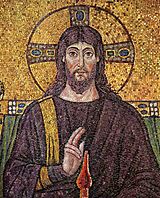 Ravenna mosaic, 6th c.: Jesus is portrayed gesturing a sign of the cross with his right hand facing outward, like a Christian priest giving a blessing. (Christ Pantocrator).
Ravenna mosaic, 6th c.: Jesus is portrayed gesturing a sign of the cross with his right hand facing outward, like a Christian priest giving a blessing. (Christ Pantocrator).
When an Eastern Orthodox or Eastern Catholic bishop or priest blesses with the sign of the cross, he holds the fingers of his right hand in such a way that they form the Greek abbreviation for Jesus Christ "IC XC". The little finger is extended to make the "I"; the index finger and middle finger are also raised, with the middle finger bent slightly so that the two fingers together form the "X"; the thumb touches the lowered third finger to signify the two "C"s. When a priest blesses in the sign of the cross, he positions the fingers of his right hand in the manner described as he raises his right hand, then moves his hand downwards, then to his left, then to his right. A bishop blesses with both hands (unless he is holding some sacred object such as a blessing cross, chalice, Gospel Book, icon, etc.), holding the fingers of both hands in the same configuration, but when he moves his right hand to the left, he simultaneously moves his left hand to the right, so that the two hands cross, the left in front of the right, and then the right in front of the left. The blessing of both priests and bishops consists of three movements, in honour of the Holy Trinity.
Some Christians make the Sign of the Cross in a way that may seem idiomatic: for example, in response to perceived blasphemy. Others sign themselves to seek God's blessing before or during an event with uncertain outcome. In Latin countries people often sign themselves in public. Athletes can be seen crossing themselves before entering the field or while concentrating for competition.
In societies with constant Christian observance the Sign of the Cross is employed during everyday activities. For example the spoon crosses the newly poured mixture before stirring, housewives bless food when placing it in the oven, potters bless the clay before creating a vessel, and one slicing bread crosses the bread with the knife before cutting, as bread is considered to represent the body of Christ.
During religious persecutions, such as in Communist Romania, some believers would hide the gesture by moving their tongues in a cross pattern inside their mouths.[citation needed]
Origins
The Christian sign of the cross was originally made in some parts of the Christian world with the right-hand thumb across the forehead only.[9] In other parts of the early Christian world it was done with the whole hand or with two fingers.[10] Around the year 200 in Carthage (modern Tunisia, Africa), Tertullian says: "We Christians wear out our foreheads with the sign of the cross".[11] Vestiges of this practice remain: some Christians sign a cross on their forehead before hearing the Gospels during Mass; foreheads are marked with an ash cross on Ash Wednesday; holy oil (called chrism) is applied on the forehead for the sacrament of Confirmation. By the fourth century, the sign of the cross involved other parts of the body beyond the forehead.
Protestant views
Although the Sign of the Cross dates to ante-Nicene Christianity, it was rejected by some of the Reformers, and is absent from most forms of Protestantism. Since the Reformation it has often been rejected by Protestants and some Low-Church Anglicans as being a Catholic practice, despite Martin Luther's positive personal view, the prescribed use of the sign in Book of Common Prayer and the defence of the sign of the cross in Anglican canon law in 1604.
Lutheranism
Among Lutherans the practice was widely retained. For example, Luther's Small Catechism states that it is expected before the morning and evening prayers. Lutheranism never abandoned the practice of making the sign of the cross in principle and it was commonly retained in worship at least until the early 19th century. During the 19th and early 20th centuries it was largely in disuse until the liturgical renewal movement of the 1950s and 1960s. Since then, the sign of the cross has become fairly commonplace among Lutherans at worship. The sign of the cross is now customary in the Divine Service.[12][13] Rubrics in Contemporary Lutheran worship manuals, including Evangelical Lutheran Worship,[14] Lutheran Service Book,[15] Lutheran Book of Worship[16] and Lutheran Worship[17] provide for making the sign of the cross at certain points in the liturgy. Most places are the same as the Roman Catholic practice, such as at the trinitarian formula, the benediction, at the consecration of the Eucharist, and following reciting the Nicene or Apostles' Creed.
Devotional use of the sign of the cross among Lutherans also includes after receiving the Host and Chalice in the Eucharist, following Holy Absolution. Sometimes there is also holy water font or baptismal font at the entrance of the church, where they may dip their fingers in it and make the sign of the cross upon entering.
Methodism
The Methodist Episcopal churches, such as the United Methodist Church, are essentially a product of the Protestant Reformation.[18] Currently the sign of the cross is less common in a Methodist service as opposed to a Catholic Mass, but on Ash Wednesday it is almost always applied by the elder on the laity. However, it is a personal choice whether or not a Methodist uses the sign for personal prayer, and is encouraged by the bishops of the United Methodist Church[citation needed]. Some United Methodist churches also perform the sign before and after receiving Holy Communion[citation needed]. Some ministers also perform the sign after blessing the congregation at the end of the sermon.[19]
Reformed Tradition
In some Reformed churches, such as the PCUSA and the Cumberland Presbyterian Church, the sign of the cross is used on the foreheads during baptism [20] or during an Ash Wednesday service when ashes are imposed on the forehead. In rare instances during a Benediction , when the minister concludes the service using the trinitarian blessing, a hand is extended and a sign of the cross is made out toward the congregation.
See also
- Christian cross
- Christian symbolism
- Genuflection
- Prayer in Christianity
- Trinitarian formula
- Veneration
- Pranāma
References
- ^ Prayer Book, edited by the Romanian Orthodox Church, several editions (Carte de rugăciuni - Editura Institutului biblic şi de misiune al Bisericii ortodoxe române, 2005),
- ^ Lev, Elizabeth (25 June 2009). "Dimming the Pauline Spotlight; Jubilee Fruits". http://www.zenit.org/article-26288?l=english.
- ^ "Sign of the Cross". http://www.newadvent.org/cathen/13785a.htm.
- ^ De myst. Alt., II, xlvi.
- ^ xxxix
- ^ III, iv.
- ^ V, ii, 13.
- ^ Andreas Andreopoulos, The Sign of the Cross, Paraclete Press, 2006, ISBN 978-1-55725-496-2, pp. 11-42.
- ^ "Catholic Encyclopedia: Sign of the Cross". Newadvent.org. 1912-02-01. http://www.newadvent.org/cathen/13785a.htm. Retrieved 2010-07-10.
- ^ Andreas Andreopoulos, The Sign of the Cross, Paraclete Press, 2006, ISBN 978-1-55725-496-2, p. 24.
- ^ "Cross and Crucifix, The - Original Catholic Encyclopedia". Oce.catholic.com. http://oce.catholic.com/index.php?title=Cross_and_Crucifix%2C_The. Retrieved 2010-07-10.
- ^ "Why Do Lutherans Make the Sign of the Cross?". Evangelical Lutheran Church in America. http://www.elca.org/Growing-In-Faith/Worship.aspx. Retrieved 2007-06-16.
- ^ "Sign of the Cross". Lutheran Church - Missouri Synod. http://classic-web.archive.org/web/20080514030356/http://www.lcms.org/pages/internal.asp?NavID=3941. Retrieved 2007-09-12.
- ^ Minneapolis:Augsburg Fortress, 2006
- ^ St. Louis: Concordia, 2006
- ^ Minneapolis: Augsburg Fortress, 1978
- ^ St. Louis: Concordia, 1982
- ^ "Can United Methodists use the sign of the cross?". United Methodist Church. http://archives.umc.org/interior.asp?ptid=16&mid=1432. Retrieved 2007-06-16.
- ^ "What is the significance of ashes being placed on the forehead on Ash Wednesday?". http://archives.umc.org/interior.asp?ptid=1&mid=2871. Retrieved 2007-06-16.
- ^ Understanding Baptism, First Presbyterian Church of Crestview and Laurel Hill, Florida.
External links
- Roman Catholic
- Sign of the Cross (entry from the Catholic Encyclopedia)
- Significance of the Sign of the Cross
- Orthodox
- Sign of the Cross (orthodoxwiki.org)
- Why do Orthodox Christians "cross themselves" different than Roman Catholics?
- The Church Council of the Hundred Chapters(1551) (Old Believers)
- Sign of the Cross[dead link] (Old Believers)
- Protestant
- Why Do Lutherans Make the Sign of the Cross? (ELCA website)
- Sign of the Cross[dead link] (Lutheran Church - Missouri Synod website)
- Episcopalian site
Gestures Friendly gestures Air kiss · A-ok · Cheek kissing · Dap greeting · Elbow bump · Eskimo kissing · Fist bump · Hat tip · High five · Hongi · ILY sign · Namaste · Sign of the horns · Shaka · Thumbs signal · WaiFormal gestures Salutes Bellamy salute · Nazi salute · Raised fist · Roman salute · Scout sign and salute · Three-finger salute · Two-finger salute · Vulcan salute · Zogist saluteCelebratory gestures Finger counting Obscene gestures Head motions Other gestures Air quotes · Anasyrma · Crossed fingers · Facepalm · Finger gun · Gang signal · Hand-rubbing · Jazz hands · Kuji-in · Laban sign · Loser · Mudra · Pollice verso · Puppy face · Shrug · Sign of the Cross · Varadamudra · V signRelated Prayers and the Catholic Church Note: Prayers in italics are normally indulgenced. Prayers of the Mass Agnus Dei · Apostles' Creed · Confiteor · Gloria in excelsis Deo · Gloria Patri · Kyrie Eleison · Litany of the Saints · Nicene Creed · Pater Noster · Sanctus · Signum Crucis
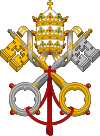
Marian prayers Other prayers Act of Contrition · Adoro te devote · Angele Dei · Anima Christi · Athanasian Creed · Ave Verum Corpus · Benedictus · De Profundis · Jesus Prayer · Laudes Divinae · Miserere mei · Morning offering · Nunc Dimittis · O Salutaris Hostia · Prayer before a Crucifix · Prayer of Saint Francis · Prayer to Saint Michael · Requiem Aeternam · Spiritual Communion · Tantum Ergo · Te Deum · Thanksgiving after Communion · Veni Creator Spiritus · Veni Sancte Spiritus · Visit to the Blessed Sacrament · Way of the Cross
Category · Portal Categories:- Cross symbols
- Sacramentals
- Gestures
- Catholic spirituality
- Eastern Orthodoxy
- Eastern Catholicism
- Oriental Orthodoxy
- Lutheran liturgy and worship
- Methodism
- Anglicanism
- Christian terms
Wikimedia Foundation. 2010.

